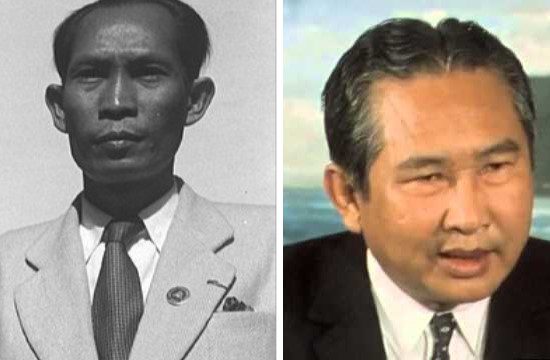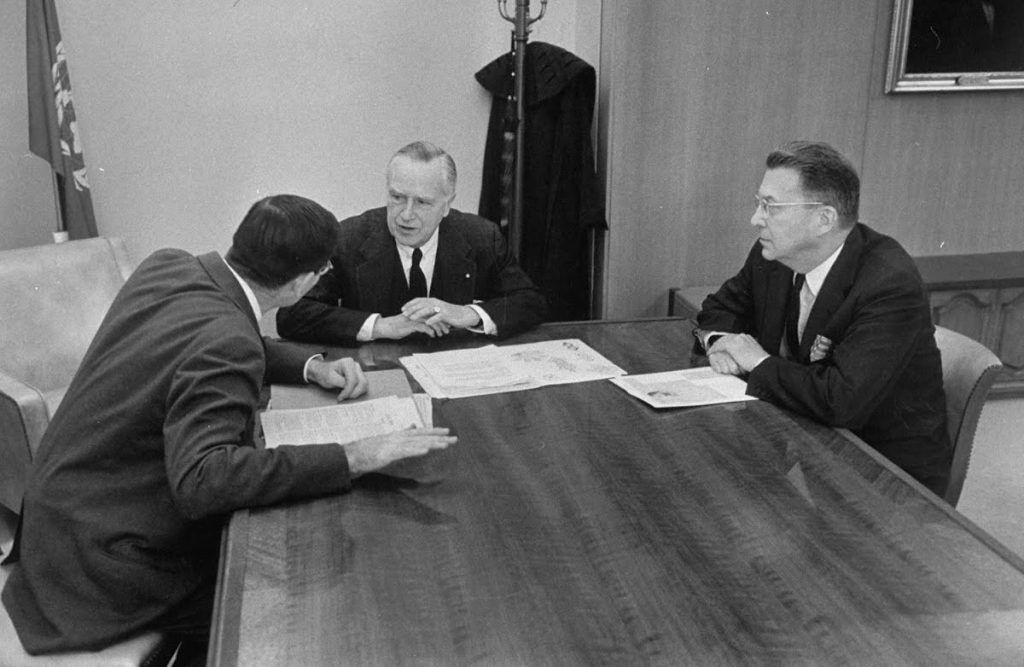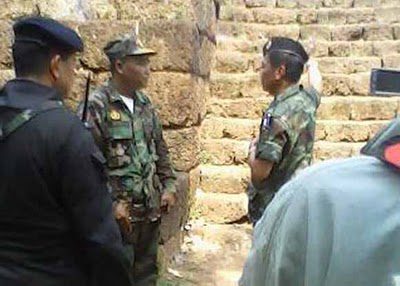On July 30, 1987, Heng Samrin journeyed to Moscow to consult with Soviet leader Mikhail Gorbachev. Then in an interview published in the Italian Communist Party daily L’Unita on August 12, Hun Sen sought to exonerate the Soviet Union from blame for Cambodia’s plight and instead blamed China for the country’s difficulties. Referring to the proposed meeting with Sihanouk, Hun Sen insinuated that Sihanouk had “bosses” who would not let him engage freely in a dialogue.
On July 30, 1998, Hun Sen, the apparent front-runner in the previous Sunday’s parliamentary balloting in Cambodia, claimed to have received the blessing of King Norodom Sihanouk for creating a three-party coalition government with two of his bitter rivals- FUNCINPEC and the Sam Rainsy Party.
On July 31, 1978, David Aikman published an essay in Time Magazine titled Cambodia: An Experiment in Genocide. Read HERE
On July 31, 1985, The Supreme Court and Prosecutor-General’s Office was created by a Decree No 28 ក្រ dated promulgating the Law on the Establishment of the People’s Supreme Court and Prosecutor-General’s Office of People’s Supreme Court.
On July 31, 1988, Prince Norodom Sihanouk arrived in Beijing on Saturday for discussions with Chinese leaders aimed at promoting efforts to bring peace to Cambodia.
“We are going to speak about the necessity for Cambodia to be an independent, neutral, unaligned country,” the then resistance leader told reporters upon his arrival.
Sihanouk said he would meet that day over dinner with Chinese Vice Premier Wu Xueqian, a former foreign minister, whom he described as “my old friend.” The prince flew in just two days after the end of inconclusive talks in Indonesia among rival Cambodian factions and Vietnamese delegates.
In Beijing, Sihanouk renewed his attacks on the Khmer Rouge. “They are torturers,” he said. “They are not my good friends. How can they be my friends, since they are not friends of their own people?”
He said, however, that the Khmer Rouge cannot be denied some power in any peace settlement. “All Cambodian factions have to unite and find an honorable compromise among themselves . . . including the Khmer Rouge….. You cannot reject them. They are there. Nobody is capable of wiping out the Khmer Rouge. So we have to try to make them less dangerous by including them in a quadripartite government.”
On July 31, 2007, Kaing Guek Eav, known as “Comrade Duch” during his administration of the infamous Tuol Sleng prison and the Santebal, a special branch of internal security for the Khmer Rouge was indicted by the ECCC, and went to trial on September 17, 2009. The indictment contained multiple counts of violations of Cambodian law, crimes against humanity, and war crimes. The trial concluded on November 27, 2010. Kaing Guek Eav was convicted on all counts on July 26, 2010, and sentenced to thirty-five years in prison. On February 3, 2012, the Supreme Court Chamber of the ECCC overturned the thirty-five-year sentence in favor of life imprisonment.
On August 1, 1969, Prime Minister Penn Nouth resigned, paving the way for Lon Nol to form a government as PM on August 13, 1969.

On August 1, 1989, the first session of the Paris Conference on Cambodia was underway. The following States participated in the Conference: Australia, Brunei Darussalam, Cambodia, Canada, the People’s Republic of China, the French Republic, the Republic of India, the Republic of Indonesia, Japan, the Lao People’s Democratic Republic, Malaysia, the Republic of the Philippines, the Republic of Singapore, the Kingdom of Thailand, the Union of Soviet Socialist Republics, the United Kingdom of Great Britain and Northern Ireland, the United States of America and the Socialist Republic of Viet Nam.
In addition, the Non-Aligned Movement was represented at the Conference by Zimbabwe.
On August 1, 1993, the Khmer Rouge detained twenty-one peacekeepers for seven hours on Thai soil when they overran a Cambodian checkpoint at the Chong Aan Ma Pass.
On August 2, 1976, The Communist Party of Kampuchea’s “Four-Year Plan” meeting ended. The Plan, a one hundred and ten page typewritten document, was drawn up at a meeting held between July 21 August 2 by the Standing Committee of the Communist Party of Kampuchea (CPK). This meeting was attended by nine men and women, including Pol Pot, Nuon Chea, Ieng Sary and Khieu Samphan. Although the document was never published or fully implemented, the activities it describes reveal the Party Center’s long-term objectives at the time of its writing.
The Party Center was primarily concerned with agricultural development. The first eighty-five pages of the Plan are devoted to establishing goals for rice production, agriculture in general, and industry. The Party’s objectives for culture, education, social action and health appear only in the last twenty pages of the document. This section, entitled “The Fields of Culture, Literature, Art, Technology, Science, Education of the People, Propaganda, and Information” indicates that the Center considered propaganda and literacy necessary components of its overall strategy to “build socialism and revolutionary consciousness.” READ
On August 3, 1959, Prince Sihanouk visited Saigon August 3–5 for a series of private conversations with President Ngo Dinh Diem. Cambodian political, financial, and military advisers to Sihanouk also held discussions with their Vietnamese counterparts. The discussions were “private” and covered the range of Cambodian-South Vietnamese problems. In their discussions with U.S. representatives, Cambodian and South Vietnamese officials stressed the cordial nature of the meetings and the apparent success of the rapprochement.
On August 3, 2008, Preah Vihear crisis: Cambodia claimed that Thailand occupied a second Angkorian-era temple complex, Ta Moan Thom and Ta Moan Touch, on the border of Oddar Meanchey Province.

On August 4, 1994, the LAW ON THE INVESTMENT OF THE KINGDOM OF CAMBODIA was adopted by the National Assembly in Phnom Penh during the extraordinary session of the first legislature.
On August 4, 1995, US Secretary of State Warren Christopher met with King Sihanouk and senior Cambodian officials in Phnom Penh. They signed AID and OPIC agreements.
On August 4, 2017, a letter with General Department of Taxation letterhead addressed to Bernard Krisher Jimusho Co Ltd, from Heng Narith, audit team chief at the department, which has been working to improve tax compliance. cited an audit of the The Cambodia Daily newspaper’s finances from 2007 to 2016, and said the company must pay about $2.39 million in taxes, $957,784 in “additional” taxes and $2.95 million in interest, and must respond within a 30-day period.
On August 4, 2019, Nuon Chea – ‘Brother No.2’ was pronounced dead at Phnom Penh’s Khmer-Soviet Friendship Hospital. He was 93 years old.
On August 5, 1952, Hun Bunal was born in Peam Kaoh Sna, Steung Trang District in Kampong Cham Province, He would later change his name to Sen and his birthday to April 4, 1951.
On 5 August 1955, the first Cambodian Delegate to UNESCO, His Royal Highness Prince Norodom Norindeth, presented his credentials to the organization.
On August 5, 1958, A US Department of State meeting was held in Washington to discuss ‘Cambodian Recognition of Communist China’. Mr. Walter Robertson, Assistant Secretary for Far Eastern Affairs, summarized the Country Team position as being that, to the extent possible in light of appropriations, the U.S. should carry on its aid program. He said that “we are all agreed that we should not terminate our aid program as a result of the recognition action since that would mean abandoning Cambodia to the Communists”. He also noted that Sihanouk would not live forever. He said that “we are all agreed that we should not now decide on changes in our aid programs in Cambodia for political reasons, but should allow the normal process of reductions because of appropriations and pre-existing Country Team’s plans to take place”. He added that it may be necessary to re-examine this question on the basis of the results of Sihanouk’s visit to Peiping (Beijing).

On August 5, 1996, General Y Chhean, secretary of state with the Defence Ministry and a former bodyguard of Khmer Rouge leader Pol Pot, met with General Tea Banh to discuss his defection t the government side.

On August 5, 2008, Kriengkrai Sampatchalit, Thailand’s Fine Arts Department director replied to Cambodia, claiming that “The Prasat Ta Moan Thom Temple is located just about 100 metres (330 ft) from the border on Thai soil.”According to the Thai authorities, the Ta Moan Thom complex is in Thai territory as evidenced by the Fine Arts Department’s registration of the ancient ruin as a Thailand national archaeological site 73 years ago in 1935, despite the ruin being 300 metres (980 ft) south of the border’s watershed ridgeline.
Tharit Charungvat, Thailand ministry’s chief spokesman said, “Thailand has not boosted the number of its troops [in Ta Moan Thom Temple].” Thai army chief Anupong Paochinda said Thai troops would remain at Ta Moan Thom because the temple is in Thailand.

On August 5, 2014, the CNRP’s 55 elected lawmakers were finally sworn into the National Assembly, bringing almost a year of post-election deadlock to an end.
